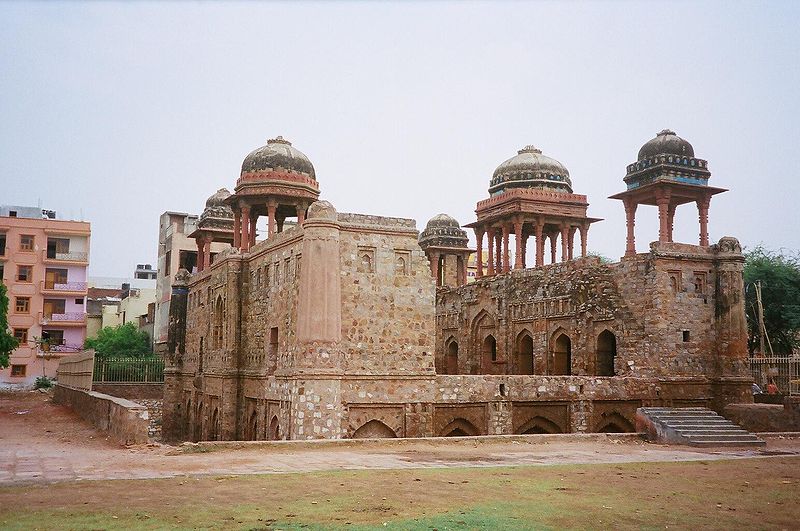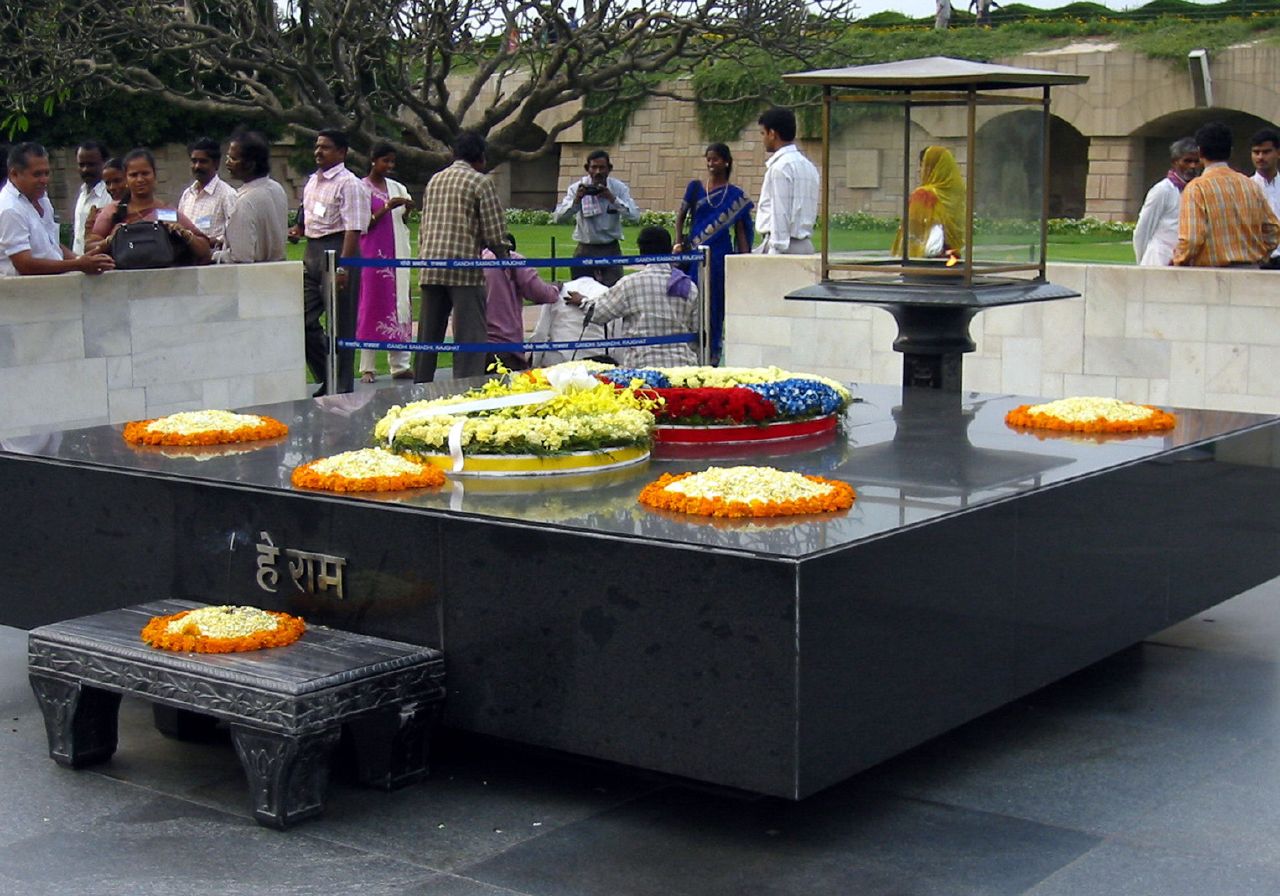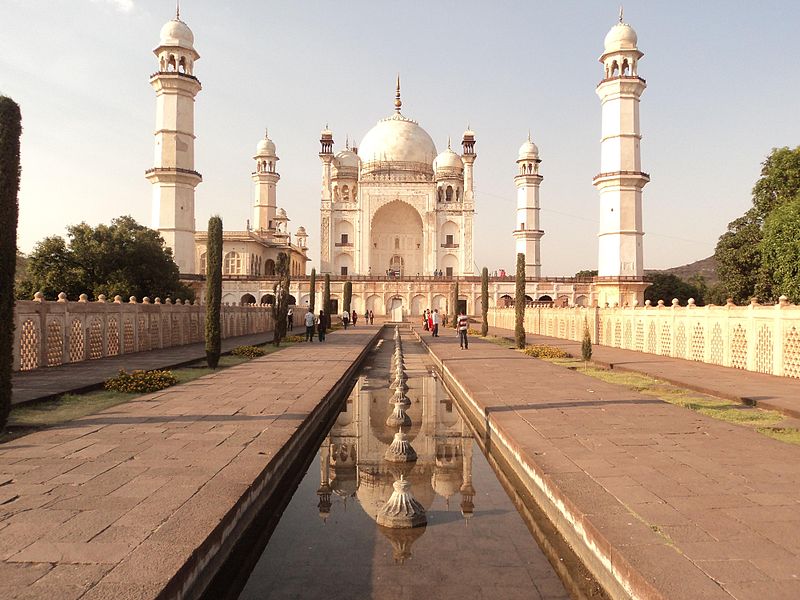Bibi Ka Maqbara
People who want to visit famous Ajanta & Ellora caves and Daulatabad fort come to the city of Aurangebad which was founded by Aurangzeb, son of Shah Jehan.
Aurangzeb built Bibi Ka Maqbara on the line of famous Taj Mahal. This monument is made of white stone and not of Marble. The structure is not as gorgeous as its counterpart but gives an impression of Aurangzeb’s architectural prowess like his father.
Mumbai
Mumbai is the richest, busiest and most important industrial and commercial centre of India. It has a Fine natural harbour, a cosmopolitan outlook, and localities that vary from over crowed slums to victorian grandeur, from the cramped small-business heart of the city to the most modern blocks of skyscrapers at Nariman Point.
Mumbai is a vibrant city, the hub not only of commerce and industry but also of culture, fashion and glamour. It is a centre of the Hindi film industry and home of many television stars. Ordinary hard working zestful citizens of Mumbai provide it with the diversity and business acumen that have ensured its success.
Calcutta
Calcutta was founded by the British just over 300 years ago. And the Victoria Memorial, a marble mixture of classical and Mughal styles sits in majestic splendor amid the green of the maidan, its galleries full of memorabilia of the Raj.
Calcutta was the second city of the British empire, but it did not lose its Indian moorings. This is the city of the 700 year old Kali Temple, of the Ramakrishna Mission, of filmmaker Satyajit Ray, and of three Nobel prize winner Mother Teresa, Rabindranath Tagore & Amartya Sen. The street are crowded. Traffic is chaotic. It has been called “ The city of Joy” in the book and a film. “Joy” is the wrong epithet, but Calcutta is a city where the human spirit does not die.
Goa
Goa’s history began before the Portuguese arrived. It is mentioned in the Purana as Govapuri. It was famous for its wealth , natural beauty and learned people, and was a port to which Arab merchants came to trade. By the 16th century the town of Goa had become the metropolis of the Portuguese in the east.
Goa is famous for its temple, churches and beaches. The most famous temple in Goa is Mangesh temple and the famous Mangeshkar family derives its name from his temple.Mangesh temple is surrounded by lush green trees and the atmosphere is very quite and calm.
Tirupati temple
Tirupati temple situated on a peak amid the Palkonda hills at the southernmost tip of Andra Pradesh. The Tirupati temple is Dedicated to Lord Venkateshwara or Balaji. It is surrounded by Sacred waterfalls, Tanks and fruit trees and a fine example of Dravidian art.
The rulers of Vijyanagar were great temple builders. They constructed thousand of them in peninsular India. The masterpiece at Tirupati is one of the oldest, most sacred and richest places of worship in the country, wit a vast concourse of devotees congregating every day. Many pilgrims, who cannot donate much else, give hair shaven from their heads as a votive offering to Balaji.
Jahaz Mahal

For over ten centuries Mandu has been loved and razed and has stood up again. Now its old monument has become the highlight of a visit to this former capital of Malwa. Jahaz Mahal is a remarkable building in the royal enclave. Shaped like a galleon, its rises above two tanks and seems to float in the air like a heavenly ship. And the pavilions on the terrace command a fantastic view of the countryside.
Ghiasuddin Khilji had it built, a place that was airy, cool and large enough to accommodate rest. Much later Shah Jehangir used to visit this Mahal. On one birthday he was weighed here against silver and precious stones. It is the largest fortified city in the world today with 45 miles of walls almost as intact as they were 3000 years ago.
Bangalore
Till the 16th century there was nothing in Bangalore except a mud fort. In the 18th century the fort was rebuilt in stone and gardens, like the Lal Bagh, were cultivated. Till recently in the 21th century Bangalore was a Garden City, a paradise for retired people because of its climate, quietude and inexpensiveness.
Bangalore spreads north and south in a planned fashion with factories,plants and pretty suburbs to house the workers and Vidhan Sabha towers over Cubbon park. Its neo Dravidian Architecture is a symbol of renascent India. It houses Karnataka Legislature, secretariat, treasury and other important offices and, when illuminated after dark, the splendid sight testifies to the economic prosperity of Bangalore.
Rajghat

A stone path, flanked by lawns, leads up to a low black marble platform which marks the spot at raj ghat where Mahatma Gandhi was cremated on 31st January 1948. Gandhiji’s Last words are inscribed on one side of the square platform – “ He Ram!”
Directly opposite this samadhi is the Gandhi Memorial which displays the Mahatma’s walking stick, sandals, spinning wheel and a few other personal items. The library houses volumes of Gandhian Literature in all languages and the entire collection of his own writings. It is all very peaceful, an appropriate atmosphere for remembering this man of Peace.
Madras
The British turned the fishing village of Madraspatnam in a fort and trading centre of the East India company in 1939-1940. With time and conquests Madras became the administrative and commercial capital of the empire in south India.
Among the Majestic civic buildings left by the British is the municipal corporation, the central Railway Station, what remains of fort St. George, and the Marina along the Coromandel coast. The city also has a number of churches and many impressive temples. Dravidian temples were and still are, fortresses of religion and the art-forms they encouraged-architecture, bronzes, Bharat Natyam dances and Carnatic music.
Nainital
The lake in Nainital shimmers like a glittering blue diamond set in the verdant Kumaon hills. The yachts that glide on it and the red roofed bouses on the surrounding tree- covered hills slopes are reflected in the water. A sulphur springs, at the Talital end continuously clears and fills the lake.
The Naini Devi temple at the opposite end was there before 18th November 1841, when the Englishman , P.Barron, chanced upon the place. He recommended it to gis friends and Naini Tal soon became a thriving summer resort. Today its pleasures include boating, horse-riding, shaded walks, a cable-car lift to snow view, and an air of permanent festivity.
Limpid Lake
The centre of attraction in Ooty is the limpid lake, and people wait expectantly near the landing stages for boat-rides. Horses can be hired for a ride around the lake or further afield. The town itself is a lovely place, nestling in misty blue hills, with tea plantations in the distance, and nearby woods ablaze with flowers and trees. The air is crisp, clean and cool.
Ooty was discovered during the Raj. John Sullivan had this artificial lake excavated in 1823. The original intention was to use it for irrigation, but it turned out to be so pretty and natural in that setting that it has been preserved for the sheer loveliness with which it enhances Ooty’s visual delights.
Image Source - Wikipedia.
